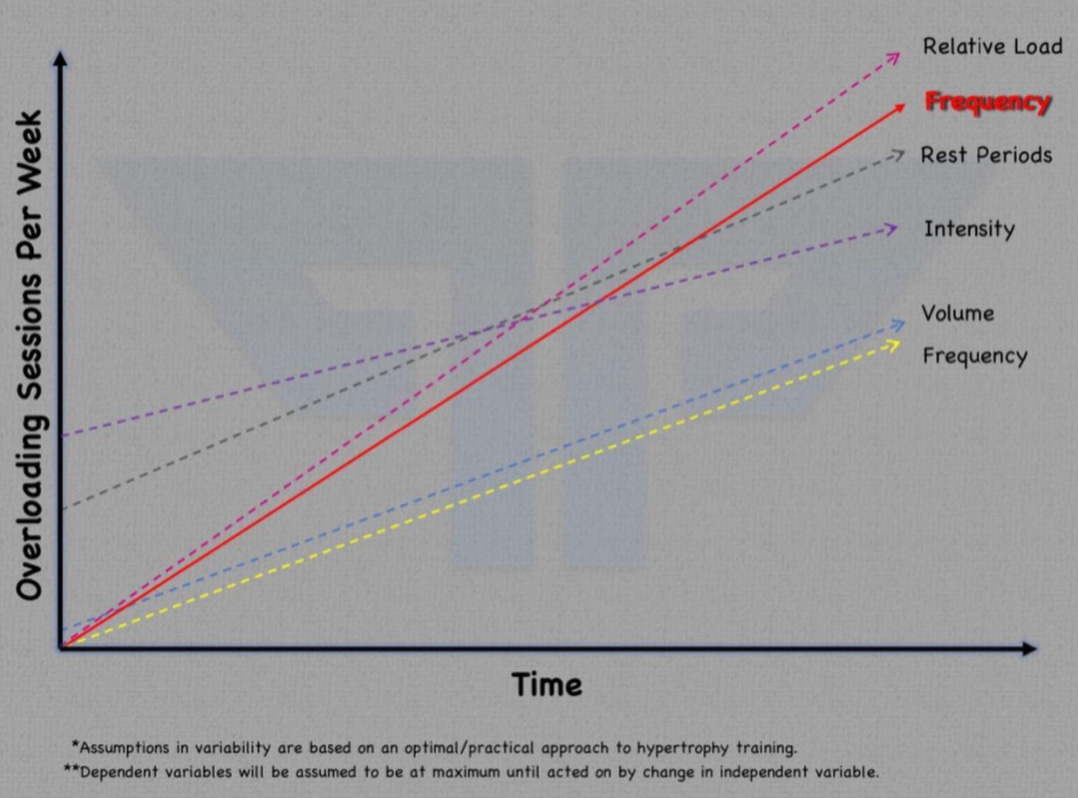A measure of how often a muscle group is trained in a given time.
Now onto — linear changes in FREQUENCY (only weekly).
- All set volume is performed on a single bodypart/lift versus divided up systemically (i.e. all sets inferred to be from leg extension/biceps curls/etc)
- Volume- 15 sets per week
- Density- 1:1 ratio with volume
- Intensity- 3RIR
- Relative Load- 70% of 1RM
- Rest Periods- 3 min between sets
The effects discussed — and graphed — are going to be a function of an isolated comparison between our independent variable (here, frequency) and a dependent variable (we will evaluate them one at a time). The above parameters will act as standardization values when those variables are not being compared directly to volume.
Volume
As we increase frequency (i.e. the number of separate instances that we’re directly training a specific muscle), this allows for a higher number of minimum-threshold sets to be performed. Additionally, this increase seems to be relatively linear. When we add more available sessions, we can distribute our volume more thinly among each, thus ensuring that no single session will severly handicap our recovery capabilities. It is not unheard of for athletes to work up to obscene amounts of volume spread across 7 days/week of training — or even multiple sessions per day!
Density
In line with volume, the density will be driven upwards as we’re able to fit more work into a single training week with rising frequency.
Intensity
Interestingly enough, our ability to push sets close to failure will actually improve as we increase our number of sessions. When we try to consolidate many highly intense sets into a single training day (or even 2 or 3), we create a massive stimulus that is difficult to recover from, both locally and systemically. However when this is better distributed, it’s the equivalent of dropping small stones in a pool at infrequent enough intervals to allow the ripples to dissipate. We’re doing enough to cause a desired effect without allowing the waves (fatigue) to grow and consume us. Conversely, performing 15 sets in a single day close to failure with 70+% of 1RM creates conditions akin to a tsunami!
Relative Load
There is now a theme developing, and relative load (vis-à-vis changes in frequency) falls right in line. Our abilities to generate sustained high forces in a single session are going to be limited by multiple factors: intramuscular glycogen stores, acute neural fatigue and even psychological exhaustion. It is already challenging to condense into 1-2 sessions the weekly volume (with sufficient intensity) that most advanced athletes need in order to progress — and this problem becomes a near-impossibility if relative load is maxed-out. When we create additional sessions, we’re able to more easily sustain high-to-VERY-high relative loads because the acute (intrasession) limitations are no longer as limiting.
Rest Periods
Once again, we see an increase across the board in our ability to rest as we more intelligently distribute volume throughout the week. Less working sets per session means a greater ability to recover in between those sets, and also a higher capacity to maintain intensity levels with heavier loads — Sounds like a good formula for hypertrophy to me!
Hmm…it doesn’t sound like there are drawbacks to indefinitely increasing frequency —the Bulgarians had it right all along!!
Or did they?
Upon closer inspection, we can find some discernible negatives that are associated with VERY high (5+ sessions/wk) or even vanilla high (3-4 sessions/wk) frequencies.
Beyond the longer recovery curves for tendons/ligaments/joints (as compared to muscle tissue), the propensity for psychological burnout, and the minimum sets-per-session threshold for hypertrophy, it is pretty obvious that attempting to train very frequently with heavy loads at high intensities leads to a substantially higher injury risk, both short and long term.
Though undulations in sessions-per-week continues to be an attractive programming manipulation that coaches and athletes tend to gravitate towards, it’s still an open research question as to what the optimal frequency actually is. Most current analyses and data point towards 2-3 sessions for most muscle groups (provided standardization of other variables), but we have seen wildly variable results in practice. There is still a ton for us to learn about how hypertrophy works that will dictate where “optimal” really lies for each individual — but until then, we can make some educated guesses!

